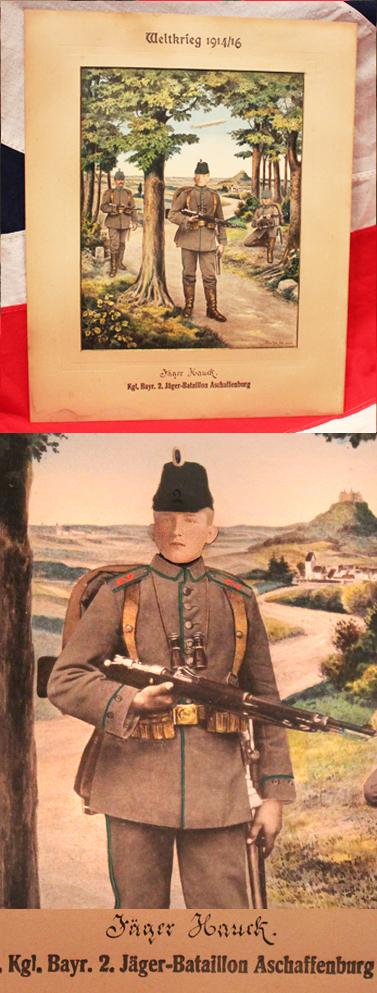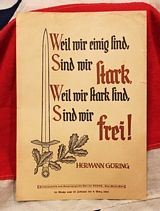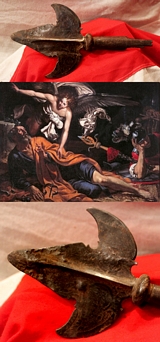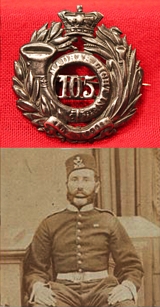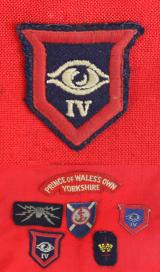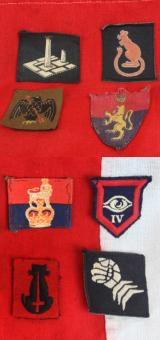An Intriguing Zeppelin Warfare Interest Original Bespoke Portrait Photo and Coloured Print of an Imperial German Rifleman in WW1 From The Photographic Wolf Studio of Ulm
A personal portrait photo of a German WW1 rifleman that has been onlaid onto the patented print, of three infantrymen, and him centre from his regiment, the 2nd Jager Battalion Aschaffenberg, Jager [rifleman] Hauck of the Bavarian Infantry in a wooded scene, and his name inscribed below. They were unique patented items that were created for the family members of the soldier for posterity. Photographic studio, A.Wolf of Ulm. 420mm x 525mm. Mounted and unframed. Would look stunning nicely reframed . One of two stunning and rare matching examples of original Great War period Imperial German Zeppelin and infantry warfare prints we acquired that we are selling separately read more
325.00 GBP
An Original Imperial German WW1 Zeppelin Warfare Interest, Bespoke. And Coloured Print of a German Infantryman, Landsturmann Lantz. From the Wolf Photographic Studio of Ulm.
Landwehr Infantry Regt. Nr.123 Ravensburg A personal portrait photo of a German WW1 rifleman that has been onlaid onto the patented print, of three infantrymen, and the subject from his regiment. Imperial German Infantrymen in a wooded scene, with a Zeppelin in the background and his name inscribed below. They were unique patented German photographic records of WW1 that were created for the family members of the soldier for posterity by a photographic studio and print shop. A Wolf of Ulm. 330mm x 450mm. Sold un-mounted and unframed. It would look absolutely stunning nicely reframed. One of two stunning and rare matching examples of original Great War period Imperial German Zeppelin and infantry warfare prints we acquired that we are selling separately. read more
325.00 GBP
WW1 Imperial German Officer's sword 73rd Reserve Regiment. Company 16 Sword 1
A gilt brass-bronze hilt with silver wire bound grip and folding shell guard, maker marked blade by Wayersberg Kirschbaum, Solingen. Regimentally marked with the Kiaser’s ordnance inspection stamp. The 19th Reserve Division, 37th Reserve Brigade, 73rd reserve infantry regiment, began the war under command of Generalleutnant Max von Bahrfeldt on the Western Front, participating in the opening German offensive which led to the Allied Great Retreat and ended with the First Battle of the Marne. Thereafter, the division remained in the line on the Aisne and in the Champagne. From May 1915 to March 1916, the division fought in Upper Alsace. It then fought in the Battle of Verdun until July, when it went into the Argonne Forest. In October 1916, it saw action in the later phases of the Battle of the Somme. In April 1917, the division fought in the Second Battle of the Aisne, also known as the Third Battle of Champagne. In May, it was sent to the Eastern Front, and fought around Riga until September. It then returned to the Western Front, where it saw action in the Battle of Passchendaele. It was back in the trenchlines at Verdun from October 1917 to April 1918. In August–September 1918, the division faced the French and American Oise-Aisne Offensive. It remained in the line until war's end. Allied intelligence rated the division as first class. No scabbard read more
395.00 GBP
A Fascinating Most Rare Original Election Propaganda Poster of a Post WW1 German Political Party That Was Absorbed Into The Nazi NSDAP German National People’s Party. Designed by Richard Müller, Chemnitz.
A Reichstag election poster of the German National People's Party.
Wohin die fahrt?
nach nationaler einheit u freiheit
wahlt deutschnational
Where are you going?
according to national unity and freedom
elect a German national
The German National People's Party (German: Deutschnationale Volkspartei, DNVP) was a national-conservative party in Germany during the Weimar Republic. Before the rise of the Nazi Party, it was the major conservative and nationalist party in Weimar Germany. It was an alliance of nationalists, reactionary monarchists, völkisch and antisemitic elements supported by the Pan-German League After 1929, the DNVP co-operated with the socialist Nazis, joining forces in the Harzburg Front of 1931, forming coalition governments in some states and finally supporting Hitler's appointment as Chancellor (Reichskanzler) in January 1933. Initially, the DNVP had a number of ministers in Hitler's government, several prominent Nazis began their careers in the DNVP., but the party quickly lost influence and eventually dissolved itself in June 1933, giving way to the Nazis' single-party dictatorship, the majority of its former members joining the Nazi party. The Nazis allowed the remaining former DNVP members in the Reichstag, the civil service, and the police to continue with their jobs and left the rest of the party membership generally in peace
During the Second World War, several prominent former DNVP members, such as Carl Friedrich Goerdeler, were involved in the German resistance against the Nazis and took part in the 20 July assassination plot against Hitler in 1944. Approx size A4. read more
220.00 GBP
Reich Marshall Herman Goering Small Propaganda Poster With Luftwaffe Sword
In very good condition for age. Rarely surviving piece from the the pre war Germany.Weil wir einig sind, sind wir stark, weil wir stark sind, sind wir frei. ... Hermann Goring", " Because We Are United We Are Strong, Because We Are Strong We Are Free" 28th of February to 6th Martch 1938. [weekly slogans of the National Socialist German Workers' Party]. Another original copy of it is in the George C Marshall Foundation library During World War II, Marshall as Army Chief of Staff (1939-1945) was the most important military figure in the U.S. military establishment and of great significance in maintaining the Anglo-American coalition. After the war, he was named special ambassador to China (1945-1947), Secretary of State (1947-1949), President of the American Red Cross (1949-1950), and Secretary of Defense (1950-1951). In 1953 he was awarded the Nobel Peace Prize for his role in proposing, encouraging legislative action, and supporting the European Recovery Program (known as the Marshall Plan). For nearly 20 years he was a major U.S. leader, militarily, politically and morally, and he is still widely admired today. read more
245.00 GBP
A Battle Worn Original Early 17th Century Italian Partizan Polearm Head
Steel three prong partizan decorated with birds on a floral background from the 1620's. Battle damaged and a fabulous artifact of 17th century warfare. With later haft [not shown] A partizan (also partisan) is a type of polearm that was used in Europe in the Middle Ages. It consisted of a spearhead mounted on a long shaft, usually wooden, with protrusions on the sides which aided in parrying sword thrusts. From the era of the Italian Wars of Castro. They were a series of conflicts during the mid-17th century revolving around the ancient city of Castro (located in present-day Lazio, Italy), which eventually resulted in the city's destruction on 2 September 1649. The conflict was a result of a power struggle between the papacy ? represented by members of two deeply entrenched Roman families and their popes, the Barberini and Pope Urban VIII and the Pamphili and Pope Innocent X ? and the Farnese dukes of Parma, who controlled Castro and its surrounding territories as the Duchy of Castro. We do have its polearm 70 inches long overall, 12.5 head incl. side straps read more
675.00 GBP
A Most Rare Victorian, Anglo Indian, British Raj, Silver 105th (Madras Light Infantry) Officer Glengarry Badge
From the British Raj, one of the most desirable eras of collectable militaria of Anglo Indian history. Pre 1881 Silver coiled bugle horn couched within crowned sprays of laurel and palm, the horn with central floreate numerals 105, on the curl of the horn Madras Light Infty.. A scroll on the junction of the leaf sprays Cede Nullis. Sealed in 1876. Became the King's Own Yorkshire Light Infantry in 1881 The 105th Regiment of Foot (Madras Light Infantry) was an infantry regiment of the British Army from 1862 to 1881, when it was amalgamated into The King's Own Light Infantry (South Yorkshire Regiment).
The regiment was originally raised by the Honourable East India Company in 1839 as the 2nd Madras (European) Regiment, redesignated the 2nd Madras (European) Light Infantry in 1842, and served in the Indian Mutiny of 1857. As with all other "European" units of the Company, they were placed under the command of the Crown in 1858, and formally moved into the British Army in 1862, ranked as the 105th Foot.
As part of the Childers Reforms in 1881, the regiment was amalgamated with the 51st (the 2nd Yorkshire West Riding) or King's Own Light Infantry Regiment to form The King's Own Light Infantry (South Yorkshire Regiment). read more
295.00 GBP
Original Uniform Removed British Formation Badges 1939-1945 & King George VIth
An embroidered cloth shoulder title for the Prince of Wales's Own Regiment of Yorkshire, comprising a base of scarlet wool cut in an arc and embroidered on obverse with the title of the regiment "PRINCE OF WALES'S OWN YORKSHIRE" in white thread, and 5 formation badges, including the 4th Guards Armoured. Formation signs were first used by the British Army in WW1 in order to provide an easy method of visual identification of the various units. They were worn on the upper sleeve in pairs, on epaulets, on head gear, painted on unit vehicles, and used on road signs. It was also quickly found that the signs created a morale boosting esprit de corps as each unit became proud of its own symbol. After WW1 the use of formation signs was discontinued, they were reintroduced at the outbreak of WW2.Divisional Signs were reintroduced early in 1940, but instructions were given in 1941 for all formation signs to be referred to as Formation Badges; the official American designation is Shoulder Sleeve Insignia. Formation badges were worn on the sleeves of uniforms except on greatcoats; in battledress, one inch below the regimental or corps shoulder title, and immediately above the arm of service strip. These were narrow two inch strips, introduced in the autumn of 1940, which gave the soldier's arm of service when wearing a steel helmet, or no cap or other distinguishing badges. Infantry battalions wore one, two, or three red strips one below the other, as in the above illustration, to indicate the brigade to which they belonged as shown here.
In tropical kit areas, such as the Middle East and Far East, the formation badges were often worn affixed to the sleeves of Kahki Drill jackets by means of press studs to facilitate laundering, or even worn stitched onto slip-on epaulettes for wearing on the shoulders of K.D, shirts; this was also the method used in the hot summer months in Italy.
On all vehicles, formation badges were stencilled in colour on the forward and rear mudguards, or on the tailboard of trucks; on jeeps the badge appeared on the body below the windscreen on the driver's side.
Officially all formation badges, and other identifying insignia such as regimental titles, were to be removed before going into battle; however, photographic evidence clearly shows that every degree of obedience to this was to be seen in Normandy, and to some extent in Italy, from completely stripped sleeve and vehicle insignia to total disregard of the order. Guards 4th armoured. london district southern commanded
read more
120.00 GBP
Original Uniform Removed 8 British Formation Badges 1939-1945 & King George VIth
Formation signs were first used by the British Army in WW1 in order to provide an easy method of visual identification of the various units. They were worn on the upper sleeve in pairs, on epaulets, on head gear, painted on unit vehicles, and used on road signs. It was also quickly found that the signs created a morale boosting esprit de corps as each unit became proud of its own symbol. After WW1 the use of formation signs was discontinued, they were reintroduced at the outbreak of WW2.Divisional Signs were reintroduced early in 1940, but instructions were given in 1941 for all formation signs to be referred to as Formation Badges; the official American designation is Shoulder Sleeve Insignia. Formation badges were worn on the sleeves of uniforms except on greatcoats; in battledress, one inch below the regimental or corps shoulder title, and immediately above the arm of service strip. These were narrow two inch strips, introduced in the autumn of 1940, which gave the soldier's arm of service when wearing a steel helmet, or no cap or other distinguishing badges. Infantry battalions wore one, two, or three red strips one below the other, as in the above illustration, to indicate the brigade to which they belonged as shown here.
In tropical kit areas, such as the Middle East and Far East, the formation badges were often worn affixed to the sleeves of Kahki Drill jackets by means of press studs to facilitate laundering, or even worn stitched onto slip-on epaulettes for wearing on the shoulders of K.D, shirts; this was also the method used in the hot summer months in Italy.
On all vehicles, formation badges were stencilled in colour on the forward and rear mudguards, or on the tailboard of trucks; on jeeps the badge appeared on the body below the windscreen on the driver's side.
Officially all formation badges, and other identifying insignia such as regimental titles, were to be removed before going into battle; however, photographic evidence clearly shows that every degree of obedience to this was to be seen in Normandy, and to some extent in Italy, from completely stripped sleeve and vehicle insignia to total disregard of the order.
Formation signs were first used by the British Army in WW1 in order to provide an easy method of visual identification of the various units. They were worn on the upper sleeve in pairs, on epaulets, on head gear, painted on unit vehicles, and used on road signs. It was also quickly found that the signs created a morale boosting esprit de corps as each unit became proud of its own symbol. After WW1 the use of formation signs was discontinued, they were reintroduced at the outbreak of WW2.Divisional Signs were reintroduced early in 1940, but instructions were given in 1941 for all formation signs to be referred to as Formation Badges; the official American designation is Shoulder Sleeve Insignia. Formation badges were worn on the sleeves of uniforms except on greatcoats; in battledress, one inch below the regimental or corps shoulder title, and immediately above the arm of service strip. These were narrow two inch strips, introduced in the autumn of 1940, which gave the soldier's arm of service when wearing a steel helmet, or no cap or other distinguishing badges. Infantry battalions wore one, two, or three red strips one below the other, as in the above illustration, to indicate the brigade to which they belonged as shown here.
In tropical kit areas, such as the Middle East and Far East, the formation badges were often worn affixed to the sleeves of Kahki Drill jackets by means of press studs to facilitate laundering, or even worn stitched onto slip-on epaulettes for wearing on the shoulders of K.D, shirts; this was also the method used in the hot summer months in Italy.
On all vehicles, formation badges were stencilled in colour on the forward and rear mudguards, or on the tailboard of trucks; on jeeps the badge appeared on the body below the windscreen on the driver's side.
Officially all formation badges, and other identifying insignia such as regimental titles, were to be removed before going into battle; however, photographic evidence clearly shows that every degree of obedience to this was to be seen in Normandy, and to some extent in Italy, from completely stripped sleeve and vehicle insignia to total disregard of the order.
7th Armoured Division The best known of all armoured divisions, The Desert Rats. It was formed in Egypt in 1938 as a Mobile Division. In December 1939 it became known as the 7th Armoured Division and its commander, Major-General O'Moore Creagh, adopted the jerboa (the desert rat) divisional sign. 6th Armoured Division(1950) Black cat on red ground with red sword = 56th (london) Armoured Division read more
135.00 GBP
An Original King George VIth Fire Service Recruitment Poster By Fosh and Cross
In the first.22 nights of air raids, from Sept 1940, firefighters fought nearly 10,000 fires.
Bombings often occurring while the River Thames was at low tide meaning access to water was made even more difficult. Vehicles became vital in transporting water around the city. Steel frames were fitted to lorries to enable them to carry up to 1,000 gallons of water. Meanwhile, to reduce the workload of the fire service, small fires were dealt with by 'street fire parties' – civilians who were given and taught to use stirrup pumps.
The public's opinion of the fire service changed significantly as a result of the Blitz. During the 'phoney war', firefighters had been thought of as 'army dodgers'. But, in 1940 this attitude changed – our firefighters became known as 'the heroes with grimy faces'. Two days into the Blitz - Churchill told the House of Commons that Adolf Hitler 'hopes by killing large numbers of civilians, that he will terrorise and cow the people of this mighty imperial city... Little does he know the spirit of the British people.'
The Auxiliary Fire Service
As the political climate intensified in Europe during the late 1930s, an Act of Parliament was passed to authorise the formation of a voluntary fire service. The Auxiliary Fire Service (AFS) formed in January 1938 and fire stations were set up in schools, garages and factories.
A recruitment drive was launched, with over 28,000 firefighters needed to support the Brigade's 2,500 officers and firefighters. However, as most young men had joined the army, the AFS welcomed those too old or too young to go to war. It also marked the first time women joined the Brigade.
Did women fight fires in WWII?
Though women did train, they didn't actually fight fires in the Second World War. They became fire watchers and drivers, and managed the communications networks. A rank system for women of the fire service was developed during the war to recognise their service and bravery – many were awarded for their remarkable achievements.
By 1943 over
70,000 women
had enrolled in the NFS in the United Kingdom. When peace was declared, London's fire service had attended over 50,000 calls though tragically, 327 of London's firefighters lost their lives. It's a sacrifice we'll never forget.
We never normally comment on the investment potential of any collectable, but the potential for all underpriced WW1, WW2 etc. posters may be incredible, for example the more famed original poster, 'Keep Calm and Carry On' can now sell for over £20,000.
Good condition 15 inches x 19.75 inches read more
295.00 GBP


